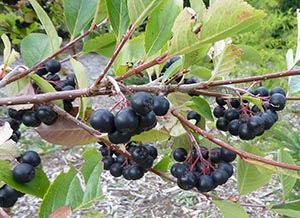Chokeberry (Aronia) Nutrition facts
Chokeberry is one of the popular berries packed with essential phytonutrients, vitamins, and antioxidants. These tiny, wild, sub-arctic berries have recently grabbed the attention of fitness lovers and food scientists alike for their promising nutritive values.
Botanically, black chokeberries belong to the Rosaceae family, of the genus: Aronia. Scientific name: Aronia melanocarpa. Red chokeberries belong to the same species and have the botanical name: Aronia arbutifolia.
 |
| Black chokeberries. (Aronia melanocarpa). (Photo: Wendy) |
At least two species of chokeberries cultivated, black and red. Black chokeberry is a small, deciduous shrub native to North American cold regions. It grows to about 5 to 8 feet tall and bears many small, about 1 cm in diameter, fruits with relatively thick, pigmented skin in pendulous clusters.
Red berries are sweeter than black varieties. However, black chokeberries are rather rich sources of the anthocyanin class of pigment antioxidants.
9 amazing Health benefits of chokeberry
Chokeberries are low in calories and fats. 100 g of fresh berries carry around 50 calories. Nonetheless, they are one of the richest sources of flavonoid anthocyanin antioxidants among bush berries. Also, they contain handsome levels of minerals and vitamins. Besides, their peel is also a good source of dietary fiber.
The oxygen radical absorbency capacity or ORAC (measurement of the antioxidant strength of food items) demonstrates chokeberry with one of the highest values recorded among berries-16,062 micromoles of Trolox Equivalents (TE) per 100 g.
Black chokeberries consist of significantly high amounts of phenolic flavonoid phytochemicals called anthocyanins. Total anthocyanin content is 1,480 mg per 100 g of fresh berries, and proanthocyanidin concentration is 664 mg per 100 g (Wu et al. 2004, 2006).
Scientific studies have shown that consumption of berries on a regular basis offers potential health benefits against cancer, aging and neurological diseases, inflammation, diabetes, and bacterial infections. (- By Dr. Paul Gross, 2007-07-09).
Laboratory analyses of anthocyanins in chokeberries have identified the following individual chemicals: cyanidin-3-galactoside, quercetin, peonidin, delphinidin, petunidin, epicatechin, caffeic acid, pelargonidin, and malvidin. These flavonoid poly-phenolic antioxidants have proven health benefits by scavenging dangerous oxygen-free radicals from the human body.
Cancer research on anthocyanins in black chokeberry extract first experimented on chemically induced esophageal cancer in rats. It was found to reduce the disease severity by 30-60% and that of colon cancer by up to 80%.
The tumor suppression activity works at a different level- at the initiation and promotion/progression stages of tumor development. Chokeberry extraction can be a practical research model, which holds a promising therapeutic resource since they contain the highest amount of anthocyanins among native North American berries [J. Agric. Food Chem. 50 (12): 3495–500].
The berries are also rich in flavonoid antioxidants such as carotenes, lutein, and zeaxanthins. Zea-xanthin has photo-filtering effects on UV rays and thus protects eyes from age-related macular disease in the elderly (ARMD).
Further, they are also good sources of many antioxidant vitamins like vitamin-C, vitamin-A, vitamin-E, beta-carotene, and folate and minerals like potassium, iron, and manganese. 100 g of fresh berries provide about 35% of the daily recommended levels of vitamin C.
Selection and storage
In the wild, chokeberries normally are picked up from their natural habitat and eaten directly after simple washing. While purchasing from the stores, choose berries that are plump, fresh, uniform, shiny, clean surface and color. Remove any wet, mottled berries since they tend to spread mold to other ones.
Chokeberries can be stored in the refrigerator for about a week. Wash them in cold water just before use to bring back their original texture.
Preparation and serving methods
Chokeberries in their natural form feature thin whitish waxy coat on them, as you may also find on other berries like grapes, blueberries, etc. Red berries are sweeter than black varieties; however, the latter possess higher levels of pigment antioxidants.
To wash, gently swish them in a bowl of cold water for a few minutes. Then mop dry using a soft cloth, taking care not to injure them. This method also brings them back to room temperature and enhances their taste and flavor.
Here are some serving tips:
Chokeberries are a great addition to ice cream tops and fruit salads.
They are also used in juice, cakes, muffins, tarts, and pies.
Dried chokeberries can be eaten alone or added to confectionery and in baby food preparations.
Chokeberry syrup has been used in a variety of recipes.
Safety profile
Chokeberry contains oxalic acid, a naturally occurring substance found in some fruits and vegetables, which may crystallize as oxalate stones in the urinary tract in some people. Therefore, individuals with a known history of oxalate urinary tract stones may not want to eat too much of these fruits and vegetables. Adequate water intake is advised in them to maintain normal urine output. Oxalic acid also interferes with the absorption of minerals like calcium and magnesium. (Medical disclaimer).
≻≻-Back to Fruits from Chokeberry. Visit here for an impressive list of all varieties of fruits with complete illustrations of their nutrition facts and health benefits.
≻≻-Back to Home page.
Further resources:
Refer Stanford School of Medicine Cancer information Page- Nutrition to Reduce Cancer Risk (Opens New Window).